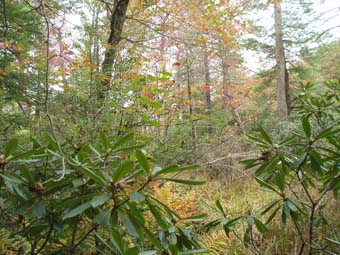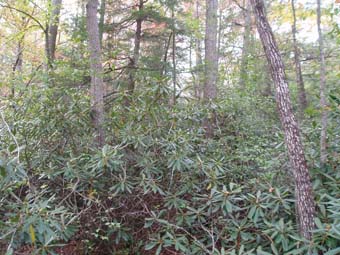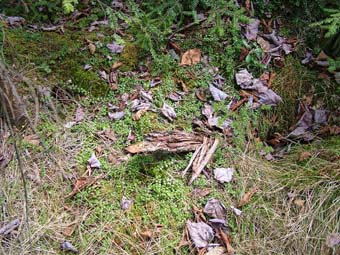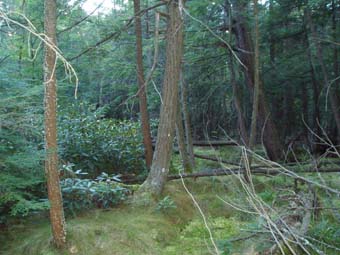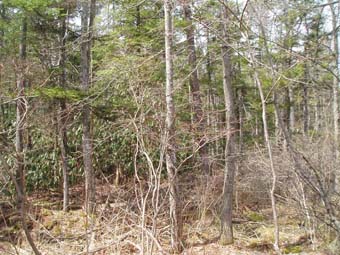Hemlock – Mixed Hardwood Palustrine Forest
System: Palustrine
Subsystem: Forest
PA Ecological Group(s): Basin Wetland
Global Rank:G5
![]() rank interpretation
rank interpretation
State Rank: S3S4
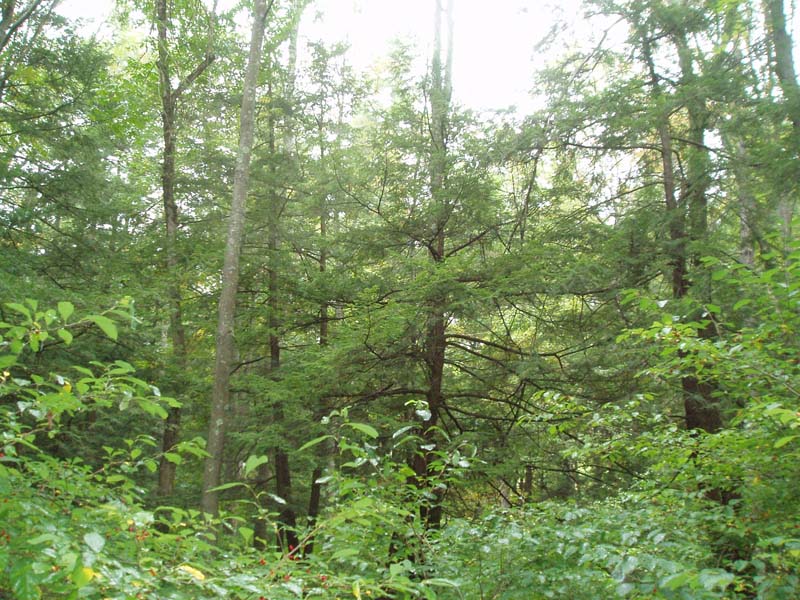
General Description
This describes a group of wetland forests that are dominated by a mixture of conifers and hardwood species. The substrate is usually mineral soil or muck over mineral soil. There is generally some groundwater enrichment in these systems. Eastern hemlock (Tsuga canadensis) contributes between 25% to 75% of the canopy. Other conifer species that may occur with hemlock include eastern white pine (Pinus strobus), red spruce (Picea rubens), and tamarack (Larix laricina). The most common hardwood species are yellow birch (Betula alleghaniensis), red maple (Acer rubrum), black ash (Fraxinus nigra), blackgum (Nyssa sylvatica), and gray birch (Betula populifolia). Rosebay (Rhododendron maximum) often forms a dense understory; other shrubs include highbush blueberry (Vaccinium corymbosum), winterberry (Ilex verticillata), swamp azalea (Rhododendron viscosum), and witherod (Viburnum cassinoides). Herbaceous species include cinnamon fern (Osmunda cinnamomea), sedges (e.g., Carex trisperma, Carex prasina, Carex leptalea), violets (Viola spp.), skunk-cabbage (Symplocarpus foetidus), false hellebore (Veratrum viride), sensitive fern (Onoclea sensibilis), partridge-berry (Mitchella repens), gold-thread (Coptis trifolia), Canada mayflower (Maianthemum canadense), crested wood fern (Dryopteris cristata), and purple-stemmed aster (Symphyotrichum puniceum). The bryophyte layer is usually well developed and may be dominated by sphagnum.
Rank Justification
Uncommon but not rare; some cause for long-term concern due to declines or other factors.
Identification
- Occurs on saturated soils in basins or depressions on the fringe of inundated areas or in backwater situations along rivers
- Hummock and hollow microtopography
- Co-dominance of Eastern hemlock in the canopy with eastern white pine, red spruce, yellow birch, red maple, black ash, black-gum, and gray birch
- Key tree species may persist in the inundated portions of the depressions/basins by growing on hummocks
Trees
Shrubs
Herbs
- Sedge (Carex leptalea)
- Sedge (Carex prasina)
- Sedge (Carex folliculata)
- Sedge (Carex bromoides)
- Creeping snowberry (Gaultheria hispidula)
- Canada mayflower (Maianthemum canadense)
- Crested shield fern (Dryopteris cristata)
- Northern wood-sorrel (Oxalis acetosella)
- Cinnamon fern (Osmunda cinnamomea)
- Goldthread (Coptis trifolia)
- Violets (Viola spp.)
- Sedge (Carex trisperma)
- Skunk cabbage (Symplocarpus foetidus)
- False hellebore (Veratrum viride)
- Sensitive fern (Onoclea sensibilis)
- Purple-stemmed aster (Symphyotrichum puniceum)
Bryophytes
* limited to sites with higher soil calcium
Vascular plant nomenclature follows Rhoads and Block (2007). Bryophyte nomenclature follows Crum and Anderson (1981).
International Vegetation Classification Associations:
USNVC Crosswalk:None
Representative Community Types:
Hemlock - Hardwood Swamp (CEGL006226)
NatureServe Ecological Systems:
North-Central Appalachian Acidic Swamp (CES202.604)
NatureServe Group Level:
None
Origin of Concept
Fike, J. 1999. Terrestrial and palustrine plant communities of Pennsylvania. Pennsylvania Natural Diversity Inventory. Harrisburg, PA. 86 pp.
Pennsylvania Community Code*
UB : Hemlock – Mixed Hardwood Palustrine Forest
*(DCNR 1999, Stone 2006)
Similar Ecological Communities
If the conifer component is less than 25% of the canopy, the community is classified as one of several broadleaf palustrine forest community types. If the conifer component is greater than 75% and dominated by Eastern hemlock, the community is regarded as the Hemlock Palustrine Forest community type. This type differs from the Hemlock – Mixed Hardwood Palustrine Woodland in that the Hemlock – Mixed Hardwood Palustrine Forest has a canopy cover greater than 60%.
Fike Crosswalk
Hemlock - mixed hardwood palustrine forest
Conservation Value
This community can host a number of rare plant species including soft-leaved sedge (Carex disperma), log fern (Dryopteris celsa), Clinton's wood fern (Dryopteris clintoniana), glade spurge (Euphorbia purpurea), creeping snowberry (Gaultheria hispidula), lesser rattlesnake-plantain (Goodyera repens), kidney-leaved twayblade (Listera smallii), bristly black currant (Ribes lacustre), and swamp red currant (Ribes triste). This community also serves as a buffer for sediment and pollution runoff from adjacent developed lands by slowing the flow of surficial water causing sediment to settle within this wetland.
Threats
Hemlock – Mixed Hardwood Palustrine Forests are threatened by habitat alteration, deposition (sedimentation, agricultural runoff) and alterations to the hydrological regime (beaver dams, lowering of water tables). Clearing and development of adjacent land can lead to accumulation of agricultural run-off and pollution, sedimentation, and insolation/thermal pollution. Eastern hemlock communities are threatened by hemlock woolly adelgid (Adelgis tsugae) infestations. A. tsugae is an exotic pest insect that feeds on the twigs of the eastern hemlocks causing defoliation, bud mortality, and, eventually, tree mortality within as little as four years (Young et al. 1995). As tree mortality occurs, light availability increases due to the widening of canopy gaps and provides opportunities for the colonization of invasive plant species within the understory (Orwig and Foster 1998).
Management
A natural buffer around the wetland should be maintained in order to minimize nutrient runoff, pollution, and sedimentation. Soil erodibility in terms of the soil texture, condition of the adjacent vegetation (mature forests vs. clearcuts) and the topography of the surrounding area (i.e. degree of slope) should be considered when establishing buffers. Impervious surfaces surrounding the wetland should be minimized to prevent thermal pollution. Direct impacts and habitat alteration should be avoided (i.e. roads, trails, filling of wetland) and low impact alternatives (i.e. elevated footpaths, boardwalks, bridges) should be utilized in situations where accessing the wetland can not be avoided. Care should also be taken to control and prevent the spread of invasive species within the wetland. Alterations to groundwater sources should be minimized.
Research Needs
Variations may occur at eco-regional levels. There is a need to collect community plot data to characterize variations of this community to assist further classification of this community. Community changes following hemlock defoliation from wooly adelgid infestations should also be studied.
Trends
The relative trend for this community is likely declining due to hydrological alterations and hemlock mortality resulting from wooly adelgid infestations. Hemlock – Mixed Hardwood Palustrine Forests were probably more common but declined due to wetland draining/filling, alterations to groundwater discharge, and clearing of the adjacent lands leading to sedimentation.
Range Map
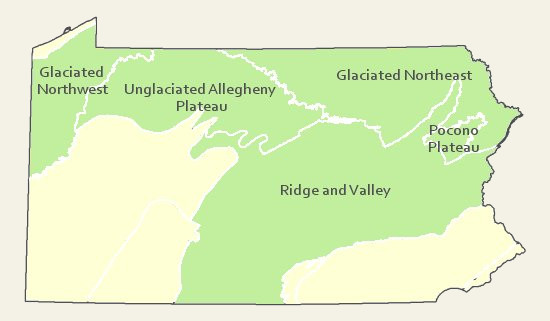
Pennsylvania Range
Glaciated Northeast, Glaciated Northwest, Pocono Plateau, Ridge and Valley, Unglaciated Allegheny Plateau
Global Distribution
The association is found in Connecticut, Maine, Maryland, Massachusetts, Michigan, New Hampshire, New Jersey, New York, Pennsylvania, Rhode Island, and Vermont. It may possibly occur in Nova Scotia.
Cowardin, L.M., V. Carter, F.C. Golet, and E.T. La Roe. 1979. Classification of wetlands and deepwater habitats of the United States. U.S. Fish and Wildlife Service. Washington, D.C. 131 pp.
Edinger, Gregory J., D.J. Evans, Shane Gebauer, Timothy G. Howard, David M. Hunt, and Adele M. Olivero. 2002. Ecological Communities of New York State. Second Edition. A revised and expanded edition of Carol Reschke's Ecological Communities of New York State. New York Natural Heritage Program, New York State Department of Environmental Conservation. Albany, NY. 136 pp.
Fike, J. 1999. Terrestrial and palustrine plant communities of Pennsylvania. Pennsylvania Natural Diversity Inventory. Harrisburg, PA. 79 pp.
Horvath, Jamie L., Timothy A. Block, and Ann F. Rhoads. 2008. Description of the population, canopy cover, and associated vegetation of the globally rare sedge Carex polymorpha (Cyperaceae) in Nescopeck State Park, Pennsylvania. In Sedges: Uses, Diversity, and Systematics of the Cyperaceae, eds. R. Naczi and B. Ford. Missouri Botanical Garden Press, St. Louis, MO.
NatureServe. 2009. NatureServe Central Databases. Arlington, Virginia. USA
Orwig, D. A., and D. R. Foster. 1998. Forest response to the introduced hemlock woolly adelgid in southern New England, USA. Journal of the Torrey Botanical Society 125: 60:73.
Pennsylvania Department of Conservation and Natural Resources (DCNR). 1999. Inventory Manual of Procedure. For the Fourth State Forest Management Plan. Pennsylvania Bureau of Forestry, Division of Forest Advisory Service. Harrisburg, PA. 51 ppg.
Rhoads, Ann F. and Timothy A. Block. 2002. Nescopeck State Park; Inventory of PNDI-listed Plants and Plant Communities. Report submitted to DCNR, Bureau of State Parks.
Rhoads, Ann F. and Timothy A. Block. 2005. Varden Conservation Area Vegetation Inventory. Report submitted to DCNR, Bureauof State Parks.
Stone, B., D. Gustafson, and B. Jones. 2006 (revised). Manual of Procedure for State Game Land Cover Typing. Commonwealth of Pennsylvania Game Commission, Bureau of Wildlife Habitat Management, Forest Inventory and Analysis Section, Forestry Division. Harrisburg, PA. 79 ppg.
Young, R. F., K. S. Shields, and G. P. Berlyn. 1995. Hemlock woolly adelgid (Homoptera, Adelgidae)-stylet bundle insertion and feeding sites. Annals of Entomological Society of America 88: 827:835.
Cite as:
Davis T. 2022. Pennsylvania Natural Heritage Program. Hemlock – Mixed Hardwood Palustrine Forest Factsheet. Available from: https://naturalheritage.state.pa.us/Community.aspx?=16029 Date Accessed: August 22, 2025


